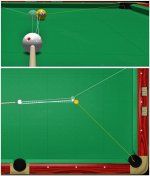Like many of you I've played pool all of my life.
I was blessed with above average hand-eye coordination.
I took lessons from Jimmy Reid many years ago (if you're not familiar with Jimmy, he was a stone cold champion - 1985 US OPEN 9 Ball Champion, World 8 Ball Champion, etc, etc...).
Jimmy taught me the fundamentals needed to be a good shot maker. These aren't any secret...but at the time he showed these to me as a kid they were life changing.
1. Your stance should always be well balanced regardless of the shot. If you're balanced, after your tip makes contact with the cue ball you should be able to freeze completely in place (head/arm/stance/all) UNTIL the cue ball stops rolling. When you can do this consistently you will play way, way, better. And when you miss, you'll KNOW why you missed (overcut, undercut, etc).
Aiming is perception so everyone will ultimately develop or fine-tune their own methods (despite the various, wonderful techniques that can help you get started...I advocate trying them all), but if they can't stay still or get in-line...they'll never REALLY know why they miss or make a ball.
Here is how I aim. It's really basic, but it works.
1. I find the line between the cue ball and a 100% full hit on the object ball (regardless of where the object ball is in relation to the pocket). I need to see that full hit first.
2. Then I look at the object ball in relation to the pocket.
3. Looking at these two perceptions helps me find the contact point. I always had a tendency to overcut everything and when I figured this out, it really helped.
4. Shoot with good fundamentals and if you miss, your brain will interpret why and should kind of automatically adjust as you progress in your game for that day. You should get these adjustments out of the way during practice and before competition each day.
I hope this might help someone.

